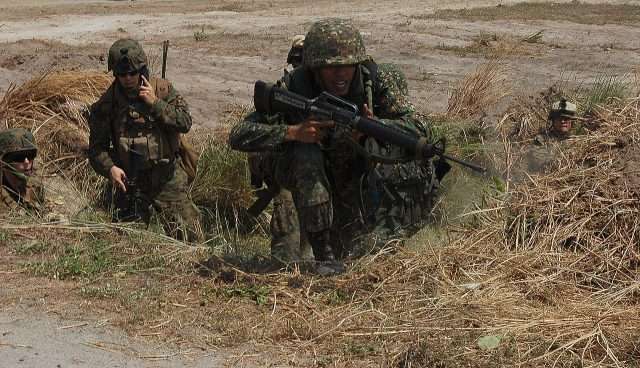The U.S.-Philippines military exercise ‘Balikatan 2022’

Author: Riccardo Rossi
The joint U.S.-Philippines military exercise ‘Balikatan 2022’ is a sign of Washington’s commitment and strategy in the Asia-Pacific to contrast further Chinese expansion in the region and strengthen military and political relations with Manila.
From March 28th, 2022, to April 8th, 2022, the United States, in agreement with Philippine President Rodrigo Duterte, is conducting the military exercise ‘Balikatan 2022’ near the Strait of Luzon. They are deploying a large military force, including 3,800 Philippine Army units and some 5,100 US Indo-Pacific Command (PACOM) assets, fixed-wing aircraft (F-16/F-18 and F-35), helicopters and the V-22 Osprey tilt-rotor.
The U.S.-Philippines partnership for the Balikatan 2022 military drills aims to foster interoperability between PACOM forces and the Philippine Armed Forces in search and rescue, maritime power projection, air combat, radar detection and maritime patrolling missions.
Geopolitical scenario
Washington interprets this typo of training activities as part of its foreign policy called Pivot to Asia, aimed at countering the political-military expansion of the People’s Republic of China (PRC) on the Eastern China Sea (ECS) and Souther China Sea(SCS), respectively delimited to the west by the Asian coastline and to the east by the first island chain, including the Japanese island territory, the island of Taiwan and the Philippine archipelago (Geostrategy and military competition in the Pacific).
In the case of the South China Sea, Washington’s doctrine of political-military contains the PRC gives a tactical-strategic role to the Philippines because from this territory it is possible to support the air-naval patrol operations of the U. S. Navy and Airforce near the geo-maritime areas of the Southern China Sea such as the Spratly and Paracelsus archipelagos and the Taiwan Malacca Straits, which are the SCS’s only entry and exit routes to adjacent seas, such as the Pacific Ocean, the ECS and the Bay of Bengal.
In recent years, Washington has strengthened its partnership with the Philippine Government to maintain control over the areas mentioned above. In 2014, the Obama administration signed the Enhanced Defense Cooperation Agreement with President Benigno Aquino III, which gave the Pentagon access to some Philippine Air Force bases, such as the military outpost of Antonio Bautista, located on the island of Palawan, near the Strait of Luzon, and the Spratly archipelago.
In this area, the People’s Republic of China has built several artificial islands with the capacity to house fixed-wing aircraft, nuclear submarines and surface ships to extend the operational range of its armed forces near Taiwan, Malacca and Luzon straits (The Geostrategic Role of the Philippines in Supporting U.S. Interests in the Southwest Asia-Pacific Area).
Thanks to the proximity of the Antonio Bautista base to the areas mentioned above, the Pentagon can deploy the Terminal High Altitude Area Defense system in this military zone (capable of targeting Chinese military man-made installations in the Spratly archipelago) and, at the same time, consider deploying its F-16, F-22, F-35, B-52 and P-8 Poseidon aircraft.
The Philippine bases represent a significant tactical-operational advantage for the planning and implementation of U.S. military operations in the South China Sea, amplified by constant military exercises such as the Balikatan 2022 and air-sea operations conducted in the SCS by the Seventh Fleet. In this regard, we might mention the deployment in the South China Sea in March 2020 of the amphibious assault ship USS America, which conducted air-sea manoeuvres with the support of the USS Gabrielle Giffords. In addition, in September 2020, the United States led the Valiant Shield 2020 manoeuvre in which both the amphibious assault ship USS America and the Nimitz-class aircraft carrier USS Ronald Reagan participated at the head of Carrier Strike Group 5 (Japan in the U.4S. Pivot to Asia Policy).
Risk Assessment
The U.S.-Philippines exercise Balikatan 2022, which is taking place these days near the Luzon Strait, as well as the other training activities planned by the United States in the South China Sea, are aimed at improving the readiness and operational effectiveness of their military instruments, observing the progress made by the Chinese People Liberation Army in the expansion of their artificial islands in the archipelagos of Spratly and Paracelsus and monitoring the Sea Lines of Communications that cross the South China Sea and in particular the Straits of Malacca and Luzon.
The Asia-Pacific has become the ‘battleground’ where China and the United States might confront each other since Beijing needs to expand its influence in the region to affirm its maritime military power and presence. At the same time, Washington aims to contain Chinese expansion and delimit the People’s Republic of China’s regional foreign policy. In this context, the Philippines offer a tactical-military advantage to the United States since, from this territory, Washington might deploy its military forces and hit Chinese interests and army. In the last years, Beijing has attempted to reduce the U.S. presence and influence in the Philippines, investing in local infrastructural projects. Indeed, in 2020, China ranked as the Philippines’ top trading partner, third biggest export market and top import supplier. From January to May 2021, China was the country’s top export market, accounting for 16.2% of total exports and the top country’s source of imports, with a share of 27%. China is also the Philippines’ most prominent source of Foreign Direct Investments (FDIs).
A future China-United States crisis in Asia-Pacific might severely damage the Philippines since Washington might use this territory for military contrast with the Chinese People Liberation Army. At the same time, Beijing might cease its financial support and investments in the Philippine territory causing domestic socio-economic problems.
Request a full SpecialEurasia report on the China-U.S confrontation in Asia-Pacific by contacting our team at this Link.
